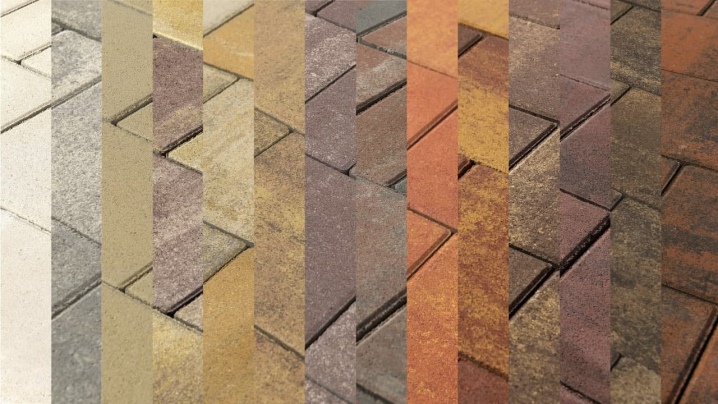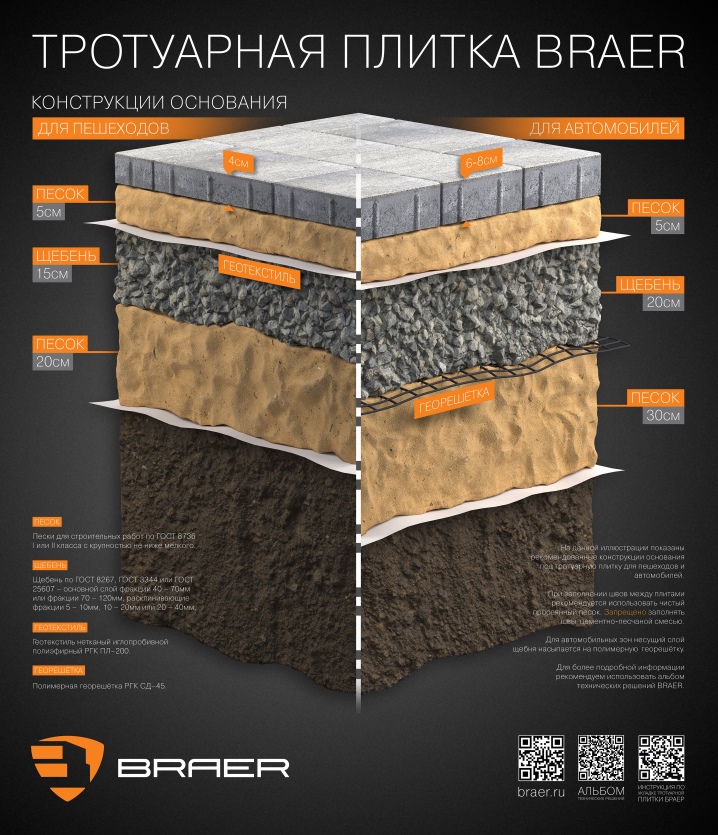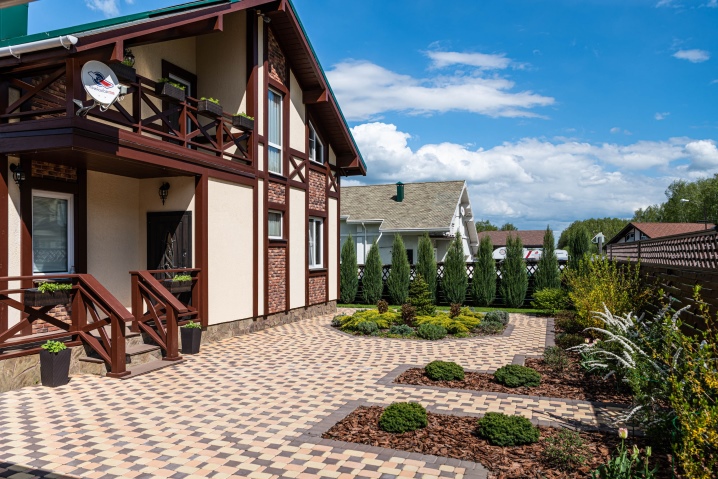What should be the modern paving slabs?

A beautifully paved front deck, driveway, or pedestrianized public space solves many landscaping challenges. The technical characteristics of paving slabs allow it not to absorb moisture from the surface, exclude slipping, and give the entire territory a neat look. But in order for the coating to serve for a long time, it must meet modern quality standards.
Features of the production of modern tiles
Modern paving slabs are not made of crushed stone, like ordinary paving stones, but are made using special equipment from concrete and other ingredients.
Double vibrocompression technology is the most advanced at the moment, provides for a fairly long production cycle. First, the necessary raw materials are selected for it. High-quality varieties of gray and white cement are best suited, as well as sand - washed or fractionated and granite crushed stone.
The technology of double vibrocompression itself looks like this in stages:
- Preparation of a semi-dry mixture.
- Pressing the base layer using special equipment.
- Pressing the face layer of the material.
The main advantage of the double vibrocompression technology is the minimization of the amount of moisture used in the production of the material. This helps to reduce the number of capillary pores inside the artificial stone. Due to the compaction, its structure is more integral and homogeneous.
This technology was developed in Germany and subsequently replaced the single-layer vibrocompression. In Russia, it is used by only a small number of manufacturers with such equipment.
Also, special attention should be paid to staining using the ColorMix technology. This solution made it possible to transform boring monotonous paving stones into the material that landscape designers dreamed of. With ColorMix, paving slabs can be painted in a wide variety of colors.

What characteristics should paving slabs have?
In order for paving slabs to withstand significant loads, it must have high performance characteristics. Among the most important points:
-
High strength, which must not be less than class B22.5.
* B22.5 is a concrete strength grade, which indicates that the tiles will be able to maintain their integrity even under high loads.
- Low abrasion, ensuring the preservation of the surface and color, despite the intensity of traffic.
-
Frost resistance with index F200.
* F200 - frost resistance class, which means that the tile can withstand sudden changes in temperature.
- Environmental Safety in accordance with the Russian standard.
- Service life is not less than 30 years.
These are the characteristics of the product BRAER plant, which has been producing paving slabs using double vibrocompression technology since 2013.
Have BRAER a wide range of small-piece concrete products. The company was one of the first in the country to install an automated line in production from the German brand HESS GROUP - the main innovator in this industry. It is on it today that paving slabs and other paving elements are produced, used in the improvement of territories for various purposes.
How to prepare for paving?
The choice of a base for paving slabs is an important task that determines the success of the entire process. It should provide sufficient elasticity, withstand significant loads, but not affect the strength of the paving itself. With the development of the technology of double vibrocompression, the process of laying tiles has also changed. In a practical way, it was found that the material fits best on a sand bed without the use of cement-sand mixtures.
The preparation of the site in this case is as follows:
- The design of the pavement is being developed, taking into account the analysis of the soil and the level of groundwater.
- Excavation is performed to the specified depth. The surface is leveled, compacted, lined with geotextiles.
- The sand pillow is being laid. For parking lots, driveways, the layer is about 30 cm, for pedestrian zones, about 20 cm is needed. Geotextiles are laid on the surface.
- Concrete elements are installed along the sides of the site - curbs, drainage trays
- A layer of rubble is filled up. The thickness ranges from 15-18 cm, based on the expected level of stress. Be sure to make a slope of 5 mm per 1 m, the surface is carefully compacted and geotextiles are laid on it.
- A finishing sand cushion with a height of 50 mm is laid, observing a slope of 5 mm / 1 m. It is compacted with a vibrating plate with a rubber nozzle.

After that, all that remains is to lay the tiles on the prepared site. Seams are filled with fine sand.
We recommend watching a video instruction on laying paving slabs from the factory BRAER.
Paving types
There are several schemes for laying paving slabs that are popular in landscape design. They are used in the standard form and standard sizes of the material:
- Brick. The scheme involves the alternation of horizontal and vertical elements in the installation. You can use different colors of the tiles, but its shape should be strictly rectangular.
- Christmas tree. The materials are stacked at an angle to each other, with the short and long sides adjoining. The choice of the masonry angle allows you to visually adjust the size of the site.
- Chaotic. In this case, tiles of different sizes and colors are combined in one coating in random order. Often this masonry scheme is used when creating coatings with an imitation of a wild stone.
- Chess. Square tiles in 2 colors are arranged symmetrically, alternating between them. The coating turns out to be strict, laconic, and looks very presentable.
- Diamonds. In this case, the figured drawing is placed in the center of the site. With the right approach, you can even achieve a 3D effect in your design.
- In circles. These can be concentric elements radiating from the center of the platform or rings that are combined with each other. Basically, a scheme of this type is used in the arrangement of pedestrian zones, patios, squares, and adjoining territories. Small format tiles are used.
- Curly. Such paving options usually involve the use of textured designer tiles. Elements are joined together strictly according to a given template. A layout is preliminarily drawn up with the display of the future coverage in 3D, taking into account the surrounding landscape.
- Mosaic. Hexagonal elements are laid according to this scheme. The pattern is formed fantastically or according to a certain pattern.
When it comes to laying non-standard design solutions, the layout scheme can be modified taking into account the wishes of the site owner. In this case, the appearance of the paving is determined only by the imagination of the author.
Variety of choices
Among Russian manufacturers, it is the BRAER company that stands out for the variety of collections of paving slabs. A detailed overview of the assortment will make sure of this. Among the most popular brand lines are:
- "Old Town Landhaus" - the most popular collection of paving slabs BRAER.Three elements of different size make it possible to apply several styling options without losing the simplicity and beauty of the paving. More than 15 color schemes will help you create a unique adjoining space!
- "Domino" - an excellent design solution for landscaping the area around the house, paths in the country and paving areas for pedestrians and car parking. A distinctive feature of the DOMINO collection is 5 elongated slabs of different sizes with a height of 60 mm.
- "Mosaic" has a universal rectangular shape and several color options.
- "Classico Circular" combines regular shapes that allow you to lay it in different directions, as well as a wide range of colors, numbering more than 10 colors.
- Meba and Green Galet - these are varieties of lawn lattice for arranging various areas: private yards, parking lots, pedestrian paths. You can choose an unusual shape that imitates natural stone, which will preserve the natural landscape and fit perfectly into any design project of the local area, or a modular structure, the cellular shape of which protects the root system from damage.
- Collection "Rectangle" due to its shape and variety of colors, it is suitable both for the improvement of the urban environment, park paths, sidewalks and squares, and for the paving of private territories.
- Louvre consists of three square elements of different sizes, which can be used both independently and in combination (this applies not only to shapes, but colors).
- "Saint Tropez" - a unique collection, this tile does not have a definite shape in the horizontal plane, which is why it resembles masonry made of natural raw stone.
- "Riviera" has four elements of a square and rectangular shape with rounded corners. Riviera paving slabs will give a respectable appearance to urban pedestrian zones and suburban areas.

It is difficult even to imagine all the variety of collections. You can choose the right paving slabs for any style of home and any landscape, limited only by your imagination!













The comment was sent successfully.